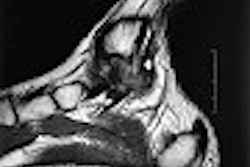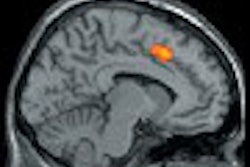Cambridge University Press, New York, 2003, $50
The study of MR physics is daunting. The path from proton precession to imaging sequence often results in a disconnect between theory and practice. This text successfully bridges that informational gap, providing beginners and veterans with a guide through the fundamentals and complexities of MR, while always connecting the physics to the images.
The authors understand that radiologists, both in training and practice, must interpret and that time and practice determine the depth of understanding. Familiarity with images is therefore at a premium. The text starts and ends with images.
Each chapter has varying depths of information. Acknowledging that the beginner may not be required to comprehend k-space to begin looking at MR images, information is presented at both an introductory and advanced level. The reader has the option to stay relatively superficial or delve into greater depths.
Staying true to its title, the text-based chapters proceed in reverse order from the traditional physics text. After a general introduction to the MR unit, indications, and protocols for exams, the chapters proceed directly to the image. The utility and unique advantages of sequences from T1 and T2 to FLAIR are reviewed with use of user friendly illustrations and figures to facilitate comprehension. Images generated by the sequence are provided with examples of normal and the pathologic.
The following chapters deal with the generation, conversion, manipulation, and optimization of the MR signal while always keeping the reader close to practice of interpreting images. The potential flaws of MR are discussed, including artifacts and ways to minimize them.
This reverse approach allows the reader to grow comfortable with the nuts and bolts of MR by relating it to what one sees on the images. The pieces start to fit together with little effort. The final chapters utilize the same format to review advanced MR applications including angiography, cardiac MR, spectroscopy, and diffusion imaging.
MRI: from Picture to Proton succeeds in explaining difficult MR concepts with a novel approach. The text is highly practical, preparing the beginner while constantly connecting the physics to the image for the senior reader. The design and content allow for increased understanding of a complex subject.
By Dr. Daniel ReidmanAuntMinnie.com contributing writer
October 29, 2003
Dr. Reidman is a radiology resident at the Madigan Army Medical Center in Tacoma, WA.
The opinions or assertions contained herein are the private views of the author and are not to be construed as official or as reflecting the views of the Department of Defense.
The opinions expressed in this review are those of the author, and do not necessarily reflect the views of AuntMinnie.com.
Copyright © 2003 AuntMinnie.com



.fFmgij6Hin.png?auto=compress%2Cformat&fit=crop&h=100&q=70&w=100)




.fFmgij6Hin.png?auto=compress%2Cformat&fit=crop&h=167&q=70&w=250)











